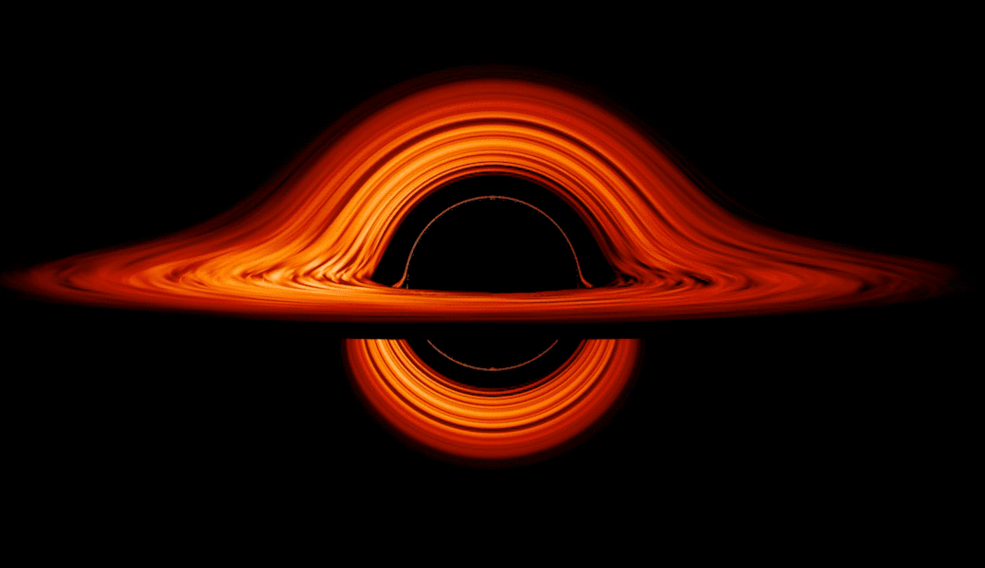He was the last physicist whose unique profile transcended the boundaries of science to become, like Einstein, an icon of popular culture. His image has remained linked to the field that accounted for the bulk of his work—black holes. The discoveries of Stephen Hawking (8 January 1942 – 14 April 2018) shone light on the darkness of these mysterious astronomical objects, but at the same time raised questions that will continue to trouble scientists for decades to come.
In the mind of the public, black holes are often imagined as huge cosmic vacuum cleaners that suck up everything in their path, including light. This is an evocative but incorrect idea. A black hole is not and does not create a vacuum, but quite the opposite; it attracts through the effect of gravity, because the density of its mass is so enormous. It follows that we should have nothing to fear if the Sun were to be replaced by a black hole of the same mass—though our world would be much colder and darker, the planets would continue to orbit undisturbed because the mass of the black hole would be equivalent to that of the Sun.
The existence of black holes stems from the theory of general relativity published by Albert Einstein in 1915, and the subsequent work of Robert Oppenheimer, Karl Schwarzschild, Subrahmanyan Chandrasekhar and others. Space and time form a fabric that is curved by mass, like a trampoline. A black hole is a ball so heavy that it has at its centre a singularity, a region so infinitely dense that it collapses the bottomless trampoline. Any object we place nearby will tend to fall towards the ball, so the gravitational effect of the black hole is felt in its surroundings. Astrophysicists have been able to identify many such black holes by discovering cosmic objects orbiting around an apparent nothingness; this gravitational pull reveals the presence of something that is otherwise completely invisible.

Lattice analogy of the deformation of spacetime caused by a planetary mass. Credit: Mysid
These black holes are often called stellar black holes; they originate after the death of a star whose internal gas pressure pushing outwards can no longer counteract the enormous force of gravity, which compresses its remaining matter until it collapses into a black hole a couple of dozen times the mass of the Sun. These are tiny compared to those that can store up to millions of solar masses, the supermassive ones that sit at the centre of many galaxies. At the other extreme, there are black holes even tinier than the stellar ones, micro-black holes formed in the early Universe.
The point of no return
Regardless of their size, they are all surrounded by an invisible boundary called the event horizon, the point of no return beyond which nothing can escape, not even light. Around that horizon the masses of dust and gas are so accelerated by the gigantic influx of gravity that they heat up and glow, emitting radiation and sometimes forming an accretion disc, which allows us to observe the shadow that the black hole itself casts on the luminous ring. Thanks to this effect, the Event Horizon Telescope (EHT), an international collaboration of ground-based radio telescopes, succeeded on 10 April 2019 in providing humanity with the first image of a black hole, which occupies the centre of galaxy M87.

In 1974, a study by Hawking published in Nature shook the science of the time by proposing that black holes were not so black, nor did they grow endlessly as physicists, including himself, had previously assumed. His genius was to combine two traditionally irreconcilable worlds, general relativity—the Einsteinian gravity used to explain the formation and evolution of black holes—and quantum mechanics, which describes the nature of the subatomic world. In his earlier papers, Hawking had shown how relativity led to the singularity of a black hole, but then it was necessary to crack open the quantum chest to explain what was going on there.
As Hawking would explain in the public version of his theory—formally incorrect for the sake of easier comprehension, as physicist Ethan Siegel explained—quantum theory suggests the continuous creation of virtual particle-antiparticle pairs that annihilate each other almost instantly. But if this happens right at the edge of a black hole’s event horizon, it may result in the negatively energetic antiparticle falling inwards, stealing energy from the black hole, and its partner escaping into space with identical positive energy. Eventually, this would lead to the total evaporation of the black hole with no matter or energy escaping from it; although, as Hawking pointed out in his study, “for a black hole of solar mass this is much longer than the age of the Universe.” In much smaller black holes it would be faster, culminating in a final explosion equivalent to “1 million 1-Mton hydrogen bombs,” he wrote.

Hawking radiation
Hawking’s demonstration that black holes can emit radiation is “his most important result,” Juan Maldacena, a physicist at Princeton’s Institute for Advanced Study who has made major contributions in string theory and quantum gravity, tells OpenMind. But at the time, this Hawking radiation opened a real schism between relativistic and quantum physicists, as the latter now had a radical problem: if, according to quantum physics, the information associated with particles is never destroyed, but no matter or energy ever escapes a black hole, how can a black hole simply disappear, taking this information out of existence?
Hawking radiation is widely accepted in current physics, although it is almost impossible to measure and therefore verify. Paradoxically, it is expelled in greater quantities by smaller, undetectable black holes, while the larger ones, those that astrophysicists can study directly, produce so little that it is indistinguishable from the Cosmic Background Radiation. But, at least, a similar phenomenon has been recreated in the laboratory: researchers at the Israel Technion Institute of Technology have generated analogues of tiny black holes that work with sound rather than light, and have managed to demonstrate something similar to Hawking radiation. These experiments have confirmed two of the physicist’s predictions: that the radiation is spontaneous—it is generated from empty space—and that it is stationary—it does not change in intensity over time.
The “soft hair” of black holes
But for its part, the so-called information paradox has remained the most important of the questions raised by Hawking’s work, in the opinion of Maldacena. This question has kept physicists busy for the last half century, including Hawking himself, who until his death searched tirelessly for a theory capable of unifying general relativity and quantum mechanics, in other words, a quantum theory of gravity that describes what happens inside black holes.
Stephen Hawking explains black holes in 90 seconds. Credit: BBC
The famous physicist’s last works proposed a solution to information retrieval. In the 1970s, John Wheeler—who popularised the term “black hole”—and Jacob Bekenstein claimed that “black holes have no hair,” in the sense that “the only properties a black hole could have were its mass, its electric charge and its angular momentum,” Cambridge University physicist Malcolm Perry, a collaborator of Hawking’s, tells OpenMind. Thus, “if one observed a black hole, you could tell nothing about how it was formed,” since all other information is lost inside it; the event horizon is, so to speak, a denuded boundary, shorn of all information.
However, in 2018, Hawking, Perry and their collaborators found a theoretical way to propose that black holes can have “soft hair”, “an infinite collection of extra properties that a black hole can have,” says Perry. As Marika Taylor, a physicist at the University of Southampton whose PhD thesis was supervised by Hawking, tells OpenMind, this metaphorical hair “suggests ways in which black holes may keep track of information at their surfaces, so that this information is ultimately recovered.”
But Perry cautions that while these ideas advance a possible resolution of the information paradox, they are not the final word. “My view is that soft hair is part of the resolution of these puzzles, but not all of it; there is further to go,” he says. Recently, other models in addition to soft hair have emerged. “There have been exciting developments about recovering information from black holes over the last year or two,” adds Taylor. For Maldacena, these new developments represent “important milestones in the analysis of the information paradox.”
According to Tom Banks, a Rutgers University physicist who shared scientific discussions with Hawking, the Briton’s contributions have been “the most important single piece of work contributing to our understanding—still very limited—of the connection between quantum mechanics and general relativity,” he tells OpenMind. This is a road that has been travelled for half a century and where much remains to be done. “Progress is good, but the timescale for solving these deepest-of-all problems is long,” Andrew Strominger, co-author of the soft hair study, at Harvard University, tells OpenMind. “We have been trying to understand black holes for a hundred years. I hope we can wrap it up in another 50.”
An animation representing one year of M87 image evolution according to numerical simulations. Source: Illinois Physics
Sadly, what will never come for Hawking is the Nobel Prize, which is not awarded posthumously and which the most popular scientist of his time never received, as it is only awarded for results in theoretical physics when they are experimentally verified. A final Hawkingian paradox was that his colleague Roger Penrose received the award in 2020 for work that the two largely developed in collaboration. “Hawking’s work was so much in advance of the relevant experiments that supporting experimental evidence was not available for much of his lifetime,” notes Taylor. “Had Hawking still been alive in 2020, it seems quite likely that he would have been awarded a share of this prize.”
Javier Yanes
Comments on this publication